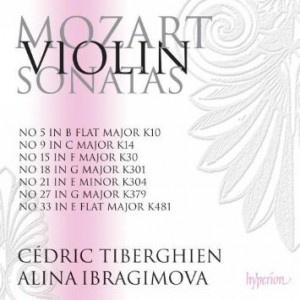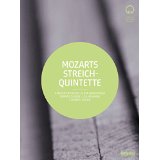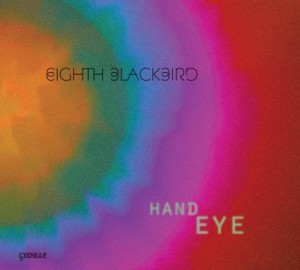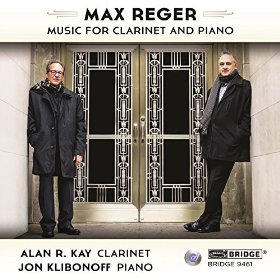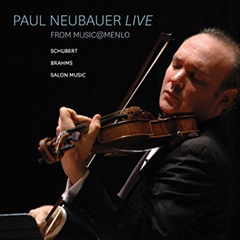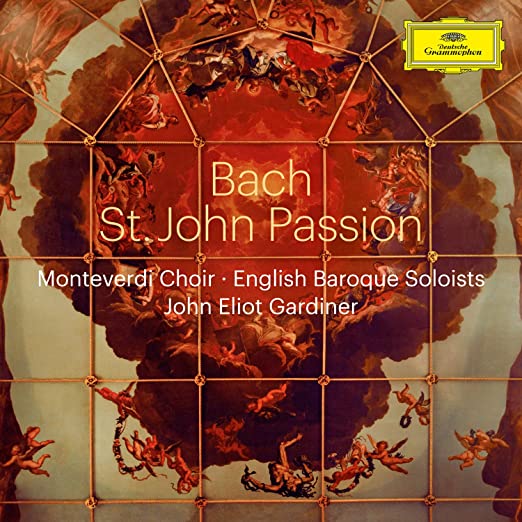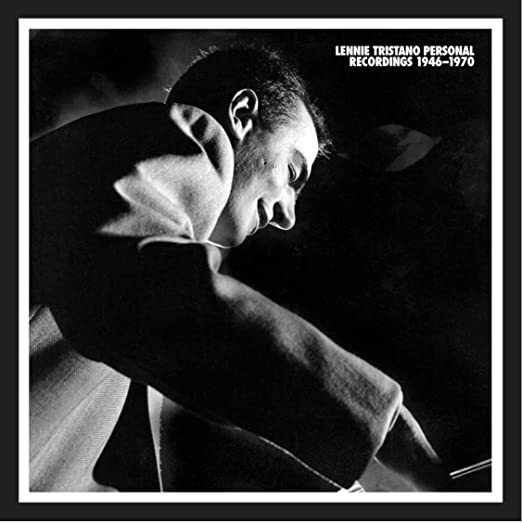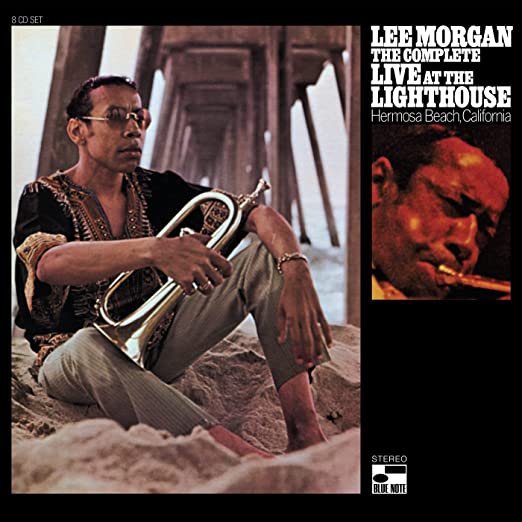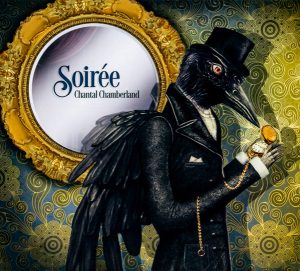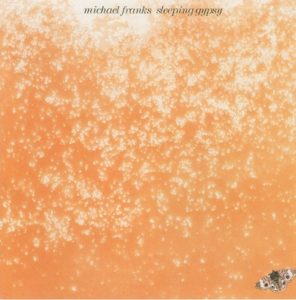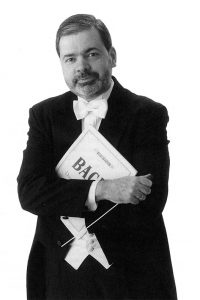Mozart, Sonatas for Violin and Piano, Alina Ibragimova, violin. Cédric Tiberghien, piano. 2 CD's. Hyperion CDA 68091.
Most of us know when we're hearing the real Mozart and not a near miss, we know in our heads and elsewhere what is required of a genuine Mozart performance. Today we have the composer's Sonatas for Keyboard and Violin, violin and keyboard, the two voices frequently having equal say. But we moderns tend to listen for the violin and can forgive a keyboardist who's a cut below the violinist who's especially strong. Thankfully in this case no forgiveness is required. Ibragimova and Tiberghien are an established duo who have already given us great performances of the Beethoven sonatas in the Music at Wigmore Hall series.
So what do we require of their Mozart to qualify as the real thing? Elegance, ebullience, grace, pace. All present. What else? What do Ibragimova and Tiberghien bring beyond these essentials? A gallante style that combines fleetness and flair. And then there is the unmeasurable quality of beauty -- and the question of what kind of beauty! Ibragimova is mainly responsible for that and we know from past experience that she won't disappoint. And we know precisely what kind of beauty she will bring. A tastefully sometimes almost feathery touch that can turn on a dime; silvery tone; and intuitive but not always predictable phrasing (we remember her idiosyncratic Bach.), which Tiberghien matches perfectly, sometimes with her, sometimes delightfully against. Their Mozart is an entirely successful joint performance, with a particular kind of beauty. We are hearing the real Mozart.
But is there any other kind of beauty for Mozart? To answer that question we turn to Rachel Podger and Gary Cooper on Channel Classics. Set alongside Podger and Cooper, Ibragimova and Tiberghien now strike us as comparatively light and aerial like...because Podger and Cooper are more vigorous and robust, thanks both to Podger's forceful, emotional style and Cooper's lean and percussive forte piano. Their Mozart is earthier. But it is also clearly authentic Mozart.
Both of these duos work but they clearly get Mozart differently. And their idea of Mozartian beauty is what is different. Put another way, if you listen to any Mozart opera you will meet and hear both aerial-like and earthy characters. Who is to say which the composer mainly inhabited when he wrote these sonatas? Our responsibility is simply to recognize his presence when it's realized. I am fond of the Podger/Cooper approach: its chutzpa challenges the expectations of most Mozart lovers -- in somewhat the way that Amodeus the movie challenged them. Elegance, ebullience, grace, and pace are all there, but it is infused with a wonderful measure of Dionysian energy. And I also very much like the new Ibragimova and Tiberghien Mozart. Its beauty sometimes borders on the transcendent.
Ibragimova brings variations of her particular aesthetic to everything she plays and many of us have learned to love it. It doesn't work entirely in her Prokofiev but her Bach, Beethoven, and Mozart are beyond reproach. I expect this new album to wear very well.
Mozart, String Quintets. Renaud Capuçon, Alina Ibragimova, Gérard Causse, Lea Hennino, Clemens Hagen. 2 DVDs. Belvidere 08004.
One of the chief, if obvious, virtues of DVD's of classical music is that they provide one of the least appreciated attributes of live music: being able to see the violist set her bow on the strings, alerting you to the particular sound you are about to hear. Anticipation is part of why we focus better at concerts than while listening to recordings. On LP's and CD's, sound surprises us as it comes out of darkness, which is why audio designers and engineers invented stereo and why many of us make such a fuss about 'imaging,' the sonic trick that substitutes for sight. Spatial imaging is a quality we are seldom aware of in 'live' music, except in those cases where a tympani on the far left or double basses on the far right make their statements. By the time most of the sound reaches us in a hall, unless we are sitting down front, the location of individual instruments has already evaporated: we hear, as we were meant to hear, a sound essentially undifferentiated in spatial terms.
I was attracted to this release partly for these reasons but also because I wanted to watch Alina Ibragimova play. She plays second violin here and so is not in a position to put her special stamp on the performance. She accompanies a fine group of French and Austrian musicians who give fulsome and vibrant performances of Mozart's string quintets. It definitely helps if you can run the audio outputs of your DVD player into a good amplifier and on to equally good speakers, which is what we non music theatre folks must do. TV sound tends to run from awful to barely acceptable. I was happy to rig such a system up given the musical and sonic quality of the results.
I enjoyed this DVD set a lot. The only criticism I'd make, typical of many activities that are filmed, is that the director considers our 'natural' view—just watching the performers perform—insufficient. He feels a need to do something to justify his existence, because he can. So he has the camera move about, peering in with close-ups on players' faces, their hands, and then moving from performer to performer. TV coverage of figure skating and opera makes the same kind of 'mistake.' A film representations of these kinds of activities doesn't need to be something different, a form unto itself. Because we are used to this, it doesn't really annoy us as we watch the Mozart quintets. It doesn't keep this production from being an excellent way to watch and listen to Mozart.
Hand Eye. Eighth Blackbird. Çedille CDR 90000162
I know noble accents
And lucid, inescapable rhythms;
But I know too,
That the blackbird is involved In what I know.
Wallace Stevens - 13 Ways of Looking at a Blackbird, No. VIII.
Another sonically compelling, musically interesting recording by the always captivating (and for those who keep score four time-Grammy winning) new music ensemble, Eighth Blackbird. This CD is based on the misguided but popular idea that music can (or should) express Pictures (or Pastoral scenes or The Four Seasons or La Mer.). So as with Mussorgsky, Beethoven, Vivaldi, and Debussy, we forgive the composers this peculiar indulgence and just enjoy their music. If that's what it takes to inspire them, so be it.
Here are six contemporary works, each 2-14 minutes long, by a group of composers who call themselves Sleeping Giant: Timo Andres, Andrew Norman, Robert Honstein, Christoper Cerrone, Ted Hearne, and Jacob Cooper. I recognize none of them and no biographical material is included, which bothers me not. Not knowing the names makes it more likely I'll/we'll listen to their music without predispositions. Thanks to Mr. Google, we can always pursue names whose music excites us. There are program notes by the composers, which we are free to ignore, at least until we're heard the music. We don't read introductions to literature before reading it either, right? The ensemble Eighth Blackbird are Tim Munro, flutes; Michael Maccaferi, clarinets; Yvonne Lam, violin; Nicholas Photinos, cello; Matthew Duvall, percussion; and Lisa Kaplan, piano.
Some of this music suffers a bit from the annoying but in this case not fatal qualities of minimalism; but all of it is great fun to listen to. The music was clearly composed with the sound and musical personality of Eighth Blackbird in mind. Much of it is bold, percussive, high contrast. Do not come here looking for mindfulness, meditation, or introspection. There are moments of relative peace but nothing approaching deliberate thought. The music is brimful of fascinating contemporary imaginative energy, so much so I found I couldn't take my ears off it. The audio engineering lets every instrument speak its piece. The prize goes to the bass clarinet in Jacob Cooper's Cast.
Max Reger. Music for Clarinet and Piano. Alan R. Kay, clarinet. Jon Klibonoff, piano. Bridge 9461.
There were many ways for a late nineteenth century composer to address and deal with the oncoming twentieth. Max Reger (1873-1916) in his music for solo violin, viola, and cello, which is all of the Reger I knew before hearing this album, chose the most conservative path: he went backwards. To Bach. Proving, at least in the first decade and a half of the twentieth century that one could still go home again. His solo works for strings are somewhat less strict than Bach's, but he is clearly their source. They are quite wonderful and there are a number of good recordings of them available.
In his duos—violin and piano, cello and piano—he took a different path, following and then moving on from Brahms, though never very far. On this album of his Sonatas for Clarinet and Piano, he follows that route. Very effectively. Reger's lyricism is lighter than Brahms' and none the worse for that. Not a great deal of Germanic brooding or sense of urgency here. The new century is nowhere in sight. We know better but the pleasure this music gives is a powerful argument against looking ahead when there is no immediate need. Reger's music for clarinet, in the sympathetic hands of clarinetist Alan Kay, can convince us that modernism is a composer's issue, not ours.
Paul Neubauer Live. From Music@Menlo. Paul Neubauer, viola, with others. Available from [email protected]
Violist Paul Neubauer, a much respected musician and long-time star of Music@Menlo, both the program and its recordings, is here given an album dedicated specifically to him. Recordings of this kind are especially difficult to evaluate and are frequently lost in the classical music marketplace. Sometimes this is just as well since many of them turn out to be little more than vanity projects and expressions of appreciation.
Paul Neubauer is far beyond needing either but being a violist there are precious few opportunities for his considerable abilities to get a spotlight. Music@Menlo has decided to rectify this situation. The program here is a mixed bag—except for the Brahms E Flat Sonata, Opus 120, No. 2, which, along with Three Songs by the same composer, are worth the price of the album by themselves. This is the most moving performance of the Sonata I've heard. Neubauer's perfect balancing of forceful statement and restraint maximize the work's very striking appeal. His performance of the Songs, with mezzo soprano Sasha Cooke and Gilbert Kalish pianist, brings out Neubauer's widely admired ability to make the viola sing, not something many violists have mastered.
We might wish for a bolder program beyond the Brahms works, but my guess is that the selection was limited to what was in the Music@Menlo archives. We get Schubert's Arpeggione Sonata and some harmless salon music to fill out the disc. No harm done. As I say, the Brahms is a treasure. So let's not be greedy.
The Way Things Go. Tara Helen O'Connor, flute. Margaret Kampmeier, piano. Bridge 9467.
How do we ordinary folk get to hear contemporary music (and musicians), assuming we live too far away from New York City, Chicago, San Francisco, and L.A.? By paying attention to the brave, small labels who dedicate themselves, at least in part, to recording them. It takes work by us to find this exciting musical culture, but it's usually worth it. I have been keeping my recent eyes on Bridge Records in New Rochelle, New York.
Which is why this brilliant new CD of contemporary music for flute and piano by flautist Tara Helen O'Connor and pianist Margaret Kampmeier arrived at my door. Part of what keeps a small label alive is finding people like me with enthusiastic open minds, even if our musical experience and expertise is... well amateur.
Composers Randall Woolf, Steven Mackey, John Halle, Eric Moe, Belinda Reynolds, Richard Festinger, and Laura Kaminsky—most born in the 1950's—are not exactly household names, with the exception of Mackey. But they are brilliant, imaginative people who obviously know who the best and most compatible musicians are and where to find them. The flute is considered, by those who haven't been around much modern flute music, to be a pastoral instrument, suitable primarily for fauns in the afternoon. But like jazz's soprano sax, in the right hands, it has many more things to do. And we are fortunate that this handful of youngish composers have been drawn to it and its possibilities. Flutes can shriek, whisper, croon, bark, breathe (!), whistle (which is different from tooting, thought the flute can do that too if it must), chirp, twitter, and both attack and make love. Most of us have no idea what a flute is capable of.
Listening to this music, I came to hear the flute as an instrument close to the voice of a human female, just as the cello is often considered the voice of a human male. And the alto flute (in Reynolds' Share) reinforces this sense: it is an alto but also a mezzo soprano. There is too much music here to describe or even summarize in these notes. All of it demonstrates that these composers have chosen the flute because nothing else can do what they want to do. They want its richness as well as its bite. No double reed could quite do this. We get the feeling that a clarinet could almost. The alto flute sometimes sounds like a clarinet in Share, until the flute moves into its lower range and we feel the rush of wind no clarinet can simulate. What a gorgeous sound. I have not knowingly ever heard an alto flute but clearly Ms. Reynolds had.
I have said nothing about the work of Margaret Kampmeier, the pianist. The best thing to say is probably that this music is unthinkable without the piano and that we are frequently aware of how important its role is here. That's the best compliment I can come up with. I suspect you'd never have heard of this album without these notes. So now you have. No more excuses!
* * * * * * *
Systems used for this audition, all headed by the Resolution Audio Cantata CD player w/BlackJack power cord: Blue Circle BC107 solid state preamplifier with NSP solid state amplifier and JM Reynaud Offrande Supreme, V2 loudspeakers. Blue Circle ELD BD solid state integrated amplifier and Orféo Supreme loudspeakers. Crimson interconnects and speaker cable; Volex power cables, Mapleshade Samson equipment rack.
Bob Neill, a former equipment reviewer for Enjoy the Music and Positive Feedback, is proprietor of Amherst Audio in Western Massachusetts which sells equipment from Audio Note (UK), Blue Circle (Canada), Crimson (UK), Jean Marie Reynaud (France), Resolution Audio (US), and Tocaro (Germany).




